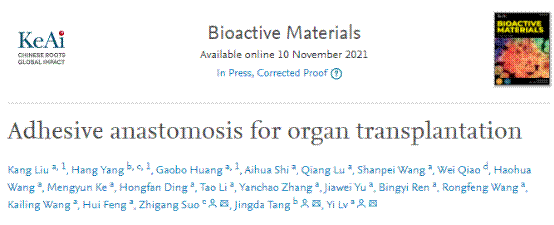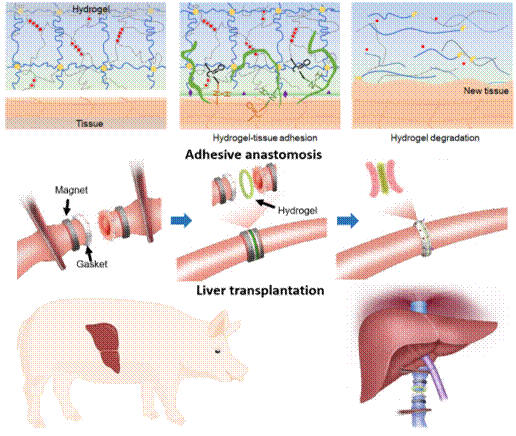On November 10, 2021,Bioactive Materials (impact factor:14.593) online published an Article entitled Adhesive anastomosis for organic transplantation, illustrating the latest research results collectively cooperated by the team led by Lyu Yi from the First Affiliated Hospital of Xi 'an Jiaotong University (XJTU), by Tang Jingda from School of Aerospace Engineering of XJTU and by Suo Zhigang from Harvard University.

The "three-point" vascular anastomosis by suture technique invented by Carrel has been applied for more than 100 years. At present, such manual suturing anastomosis is still the only method to anastomose vessels in liver transplantation. How to minimize the difficulty of vascular anastomosis and shorten the anhepatic phase is the goal of liver transplantation surgeons. Consequently, it is urgent to explore a novel vascular anastomosis technique to bring revolutionary progresses to the field of surgery. In recent years, many studies have been conducted to improve the vascular suturing technique, whereas no breakthroughs have been achieved in the field of organ transplantation.
Magnetic force has the characteristics of "automatic attraction with things in between", which has unique advantages in vascular anastomosis. In 2001, Professor Lyu Yi's team began to explore the application of magnet-assisted vascular anastomosis in liver transplantation. After the vascular magnetic anastomosis ring underwent several cycles of evolution, magnet-assisted vascular anastomosis has been successfully performed in 6 cases of liver transplantation in 2020, and the anhepatic phase has been significantly shortened from 45 min to 10 min on average. However, manual suture is still required during magnet-assisted vascular anastomosis. In the presence of magnets, the sewing needle will be attracted by magnetic force. Hence, there is still room and demand for innovation in the surgical convenience.
To resolve these issues, Professor Lyu Yi's team cooperated with team led by Professor Suo Zhigang from Harvard University and Associate Professor Tang Jingda from School of Aerospace Engineering of XJTU to develop the "magnet-assisted hydrogel adhesive" anastomosis technique, which utilizes magnetic assistance to rapidly reopen the bloodstream, and provides the coating area for hydrogel and external pressure required to form strong adhesion. After the hydrogel has formed strong adhesive effect, the magnets are removed, and secondary sewing can be avoided. The team has successfully applied the "magnet-assisted adhesive" anastomosis technique into liver transplantation of large animals. The vascular anastomosis is excellent, the bloodstream is reopened, and the animals recover well after the surgery.

Liu Kang from our hospital is the first author. Postgraduate student Yang Hang from School of Aerospace Engineering of XJTU and Huang Gaobo, a postgraduate student major in surgery (enrolled in 2019) from XJTU are the co-first authors. Professor Suo Zhigang from Harvard University, Associate Professor Tang Jingda from XJTU and Professor Lyu Yi from our hospital are the corresponding authors. Our hospital is the first affiliation of this article.